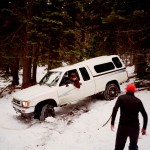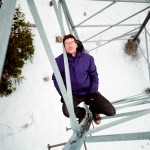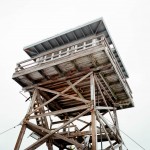Flag Point Lookout
SECTION No1 Introduction
In the winter when Flag Point Lookout is available, the trip in (time/distance/mode) all depend on the road conditions—basically how low is the snow (elevation), how deep the snow is (do you have 4-wheel drive, do you have good tires) and the quality of the snow (can you ski or do you have to snowshoe instead). In a bad year it could take six hours or more to get there, in a good year, 2 hours or less. The tower is furnished: one soiled and clapped-out mattres, a table and chairs, an island-style bar and two stools in the center of the room, a wood burning stove and a kitchen sink; including dishes, pans and a kettle. In a cupboard above the sink we found many cans of food including Hormel Chili. In a book shelf under the bar counter-top we found board games including Yahtzee!, and books including an outdated (as in quaint) Survival Manual. During the day we climbed the neighbor’s place (an antenna tower), took turns shooting pine cones at each other with the one sling shot and wandered around in the woods to the east looking for an alleged spring. At night we played board games, drank hot chocolate, drank, smoked marijuana and held a dance party - during which we placed, for acoustical optimization, our iPhones in a large metal soup pot when it was our time to DJ.
SECTION No2
Regarding Fire Towers and their Relevance by Kyle Von Hoetzendorff
THE GREAT FIRE OF 1910, ALSO KNOWN AS THE BIG BLOWUP, burned 3,000,000 acres (12,000km)11This is roughly equal to the entire land mass of Connecticut. through the states of Washington, Idaho, and Montana.22It was during that Big Blowup that legendary forester and wildland firefighter Ed Pulaski saved 40 out of 45 men by forcing them to take cover in an abandoned mine. With the fire approaching he threatened to shoot any man who attempted to flee, knowing they would only perish in their attempt. He would later go on to invent the “Pulaski.” It is still arguably the largest forest fire ever in recorded history, and did much to inspire the fire rules, organizations, and policies that we have today. One of the rules as a result of the 1910 fire stated, “all fires must be extinguished by 10:00 AM the following morning.”
Suppression. The last century of firefighting will be noted for its suppression. Fires snuffed out in their infancy,pyro-infanticide. The destruction from fire is unsightly—charred moonscapes do not attract your typical tent-toting weekender, and the cost to property can be astronomical. In the worst-case scenarios these incendiary tsunamis can cause serious injury and death.
The truth is that fire is completely terrifying.”- KVH;Fearing fire is one of the first lessons we learn, when early on we carelessly taunt whipping flames, at best ending up screaming in pain. Lesson learned. Despite our fears, wildfires are necessary; they cleanse the understory of our forests and help foster healthy and vibrant ecosystems. In places where the policy of suppression has been most effective forests have filled with dead trees and overgrown understory. This creates a succession of ladder fuels33“Ladder Fuels: An Explanation” by Firescape LLC, PDF that allow ground fires to easily climb into the fuel-laden canopy. This is fertile ground for an uncontrollable inferno known as a firestorm.44In the movie Firestorm, former NFL All-Pro defensive end Howie Long—fresh off a supporting role in the nuclear-terrorism-aviation-heist-thriller Broken Arrow—plays Jesse Graves, a long time smokejumper pitted against a group of escaped convicts hellbent on gaining their freedom. The convicts, in staging their escape, start an uncontrollable wildfire that threatens to destroy them all. This film currently has a 12% approval rating from Rotten Tomatoes. These fires rage with such fury and heat that they create their own weather system: massive Dyson-inspiring convection sucks oxygen to the fire, feeding the towering flames. Firestorms burn at an intensity that incinerates everything in the vicinity, even scorching life hidden underground and leaving the afflicted areas barren for years. Ultimately, the policy of suppression has proven to be the wrong approach to environmental management. It was an honorable attempt, at least in part, to preserve nature’s splendor while helping to inspire a nation of increasingly environmentally-conscious citizens.
Throughout the 19th and early 20th centuries the Forest Service’s policy of fire suppression required massive resources devoted to monitoring the far reaches of our nations forests. Before drones, cell phones, GPS, helicopters, airplanes and automobiles, a system of lookout towers was put in place to help identify new forest fires. These remote and precarious domiciles dotted the far recesses of our nation’s forests; they were frontline citadels in the fight against forest fires—think of a Great Wall of China where the opponent is a giant wall of fire instead of the Mongol horde. Backwoods townships and remote rural settlers relied on the lookouts to help stop the blaze before it became a threat. Tower residents used carrier pigeons, telegraphs, and heliographs55A heliograph is a wireless solar telegraph that signals by flashes of sunlight—generally using Morse code—reflected by a mirror. to send news of any new spark.
The advent of modern measuring systems has seen to a slow decline in the use of manned fire lookout towers. It is this disuse that makes them special. Without the duty of scanning for the apocalypse, visitors are free to take full advantage of the towers fundamental feature: their mind-numbingly gorgeous views.66True, not all fire look out towers have a great view, but if you end up planning a trip to a fire tower without one you have more important things to worry about. Windows were maximized during construction, and the good ones have enough room to cook, sleep, and play card games with a few friends. Mostly though, you spend your time gazing. Standing on spindly legs high above an ocean of trees, shuddering in the wind, the clock with its restless hands fades, time becomes diffuse. The nature of time changes, its measurement becomes the inconsistent creaks of the building, the whistling of a forest bird, the groaning of branches. Our need to measure things is lost in the endless horizon of our surroundings.
As much an exclamation as a remote and desirable escapist location, fire lookout towers are the true tree forts, now made available for societal escapism. Time is suspended, on hold until we climb down again. Look out.”- KVH;SECTION No3 Flag Point Lookout




 PROJ Y Casting
PROJ Y Casting  PROJ Y WOF
PROJ Y WOF  Lunar Bikepacking
Lunar Bikepacking  Prospectus
Prospectus  The Dead Reckoning Book
The Dead Reckoning Book  starter pack
starter pack  Bikepacking 101
Bikepacking 101  Dead Reck is Dead
Dead Reck is Dead  Introduction
Introduction  Day 01
Day 01  Day 02
Day 02  Introduction
Introduction  Day 01
Day 01  Day 02
Day 02  Day 03
Day 03  Introduction
Introduction  Day 01
Day 01  Day 02
Day 02  Day 03
Day 03  Day 04
Day 04  Day 05
Day 05  Day 06
Day 06  Introduction
Introduction  Day 01
Day 01  Day 02
Day 02  Day 03
Day 03  Day 04
Day 04  Introduction
Introduction  Day 01
Day 01  Day 02
Day 02  Day 03
Day 03  Introduction
Introduction  Day 01
Day 01  Day 02
Day 02  Day 03
Day 03  Introduction
Introduction  Day 00
Day 00  Day 01
Day 01  Day 02
Day 02  Day 03
Day 03  Day 04
Day 04  Instagram Symposium
Instagram Symposium  Introduction
Introduction  Day 00
Day 00  Day 01
Day 01  Day 02
Day 02  Day 03
Day 03  Day 04
Day 04  Day 05
Day 05  Day 06
Day 06  Day 07
Day 07  Introduction
Introduction  Day 00
Day 00  Days 01-02
Days 01-02  Day 03
Day 03  Day 04
Day 04  Day 05
Day 05  Day 06
Day 06  Days 07-08
Days 07-08  Day 09
Day 09  Lord Nerd Beta
Lord Nerd Beta  Base Camp: Motel on Carroll, Dunedin
Base Camp: Motel on Carroll, Dunedin  Day 01: Dunedin to Danseys Inn
Day 01: Dunedin to Danseys Inn  Day 02: Danseys Pass to Ida Railway Hut
Day 02: Danseys Pass to Ida Railway Hut  Day 03: Ida Railway Hut to Omarama Pass
Day 03: Ida Railway Hut to Omarama Pass  Day 04: Omarama to Huxley Forks
Day 04: Omarama to Huxley Forks  Day 05: Huxely Forks to Brodrick Pass
Day 05: Huxely Forks to Brodrick Pass  Day 06: Brodrick Pass to Wanaka
Day 06: Brodrick Pass to Wanaka  Lord Nerd Beta
Lord Nerd Beta  Preface
Preface  Day 01: Charazani to Hichocollo
Day 01: Charazani to Hichocollo  Day 02: Hichocollo to Pelechuco
Day 02: Hichocollo to Pelechuco  Day 03: Pelechuco to Mountainside Bivouac #1
Day 03: Pelechuco to Mountainside Bivouac #1  Day 04: Mountainside Bivouac #1 to Hilo Hilo
Day 04: Mountainside Bivouac #1 to Hilo Hilo  Day 05: Hilo Hilo to Mountainside Bivouac #2
Day 05: Hilo Hilo to Mountainside Bivouac #2  Day 06: Mountainside Bivouac #2 to Curva
Day 06: Mountainside Bivouac #2 to Curva  Outro
Outro  Lord Nerd Beta
Lord Nerd Beta  Day 01: Oasis to Bishop
Day 01: Oasis to Bishop  Day 02: Bishop to North Lake
Day 02: Bishop to North Lake  Day 03: North Lake to Piute Pass and Back to Piute Lake
Day 03: North Lake to Piute Pass and Back to Piute Lake  Day 04: Piute Lake to Bishop
Day 04: Piute Lake to Bishop  Day 05: Mono Hot Springs
Day 05: Mono Hot Springs  Lord Nerd Beta
Lord Nerd Beta  Day 00: The Approach
Day 00: The Approach  Day 01: Tyax Lodge to Iron Pass
Day 01: Tyax Lodge to Iron Pass  Day 02: Iron Pass to Graveyard Valley
Day 02: Iron Pass to Graveyard Valley  Day 03: Graveyard Valley to Trigger Lake
Day 03: Graveyard Valley to Trigger Lake  Day 04: Trigger Lake to Tyax Lodge
Day 04: Trigger Lake to Tyax Lodge  Flooded with Feeling
Flooded with Feeling  Wilderness
Wilderness  Mike Cherney on Black Bears
Mike Cherney on Black Bears  Rope Swing
Rope Swing  Slash Piles
Slash Piles  Nylon
Nylon  Conversations with a Black Bear
Conversations with a Black Bear  US Route 93
US Route 93  Turnagain Mud Flats
Turnagain Mud Flats  Bushwhacking in British Columbia
Bushwhacking in British Columbia  Men’s Penury
Men’s Penury  Bob Dittler et. al.
Bob Dittler et. al.  Bushwhacking in the MSOJ
Bushwhacking in the MSOJ  Mike Cherney’s Knife
Mike Cherney’s Knife  Hideout, UT
Hideout, UT  Hoover Dam
Hoover Dam  Shoe Tree
Shoe Tree  Destruction
Destruction  The Siskiyou Mountain Club
The Siskiyou Mountain Club  Coral Pink Sand Dunes State Park
Coral Pink Sand Dunes State Park  EN 417 – Normes Européennes 417 – The Lindal Valve
EN 417 – Normes Européennes 417 – The Lindal Valve  Wolf Satellite
Wolf Satellite  Itchy and Scratchy
Itchy and Scratchy  Tanoak Dust
Tanoak Dust  Lake Havasu
Lake Havasu  Knife Fighting
Knife Fighting  The Comfort Inn Covenant
The Comfort Inn Covenant  The Wrong/Right Way To Experience Montauk
The Wrong/Right Way To Experience Montauk  Ohiopyle Falls
Ohiopyle Falls  Allosaurus via Lean-to
Allosaurus via Lean-to  Lyle Ruterbories, Glacier National Park Ranger
Lyle Ruterbories, Glacier National Park Ranger  Water Interface Experimentation (WIE)
Water Interface Experimentation (WIE)  OSOs & UOSOs e.g., Mt. Oberlin
OSOs & UOSOs e.g., Mt. Oberlin  Louisiana Custom Cars
Louisiana Custom Cars  Archaeologizing, Pt. II
Archaeologizing, Pt. II  Archaeologizing, Pt. I
Archaeologizing, Pt. I  Mather Point
Mather Point  Sarah Plummer Lemmon & Matt Hall
Sarah Plummer Lemmon & Matt Hall  Kangaroo Lake and Fran
Kangaroo Lake and Fran  Minor Religions of the Mt. Shasta Region
Minor Religions of the Mt. Shasta Region  The Fist Bump
The Fist Bump  The Ideal Shelter
The Ideal Shelter  Headwaters of the Sacramento River
Headwaters of the Sacramento River  Buckle Bunnies
Buckle Bunnies  DFKWA: Baldface Creek - Part I
DFKWA: Baldface Creek - Part I  Mule Deer Radio Collaring
Mule Deer Radio Collaring  The Disappearance of Everett Ruess
The Disappearance of Everett Ruess  Dall Sheep Kebabs
Dall Sheep Kebabs  The Ideal Woodsman Knife
The Ideal Woodsman Knife  DFKWA: Rough and Ready Creek - Part I
DFKWA: Rough and Ready Creek - Part I  Rowdy Water
Rowdy Water  Killing a Mountain Caribou
Killing a Mountain Caribou  Boredom, Slingshots, and Prairie Dogs
Boredom, Slingshots, and Prairie Dogs  We Would Like to Visit
We Would Like to Visit  Black Bear Ranch
Black Bear Ranch  Origins
Origins  The Heart of the Klamath
The Heart of the Klamath  Skid Town Bicycles
Skid Town Bicycles  Low Stress Management
Low Stress Management  CLUB MACHO
CLUB MACHO  Club Macho Ep. 01
Club Macho Ep. 01  Club Macho Ep. 02
Club Macho Ep. 02  Club Macho Ep. 03
Club Macho Ep. 03  Cumberland Permanent
Cumberland Permanent  Iron Goat Permanent
Iron Goat Permanent  Natchez Trace Permanent
Natchez Trace Permanent  Trail of Tears Permanent
Trail of Tears Permanent  (Dis)Enchanted Rock Permanent
(Dis)Enchanted Rock Permanent  MSOJ Permanent
MSOJ Permanent  Shorty Peak Lookout
Shorty Peak Lookout  Deer Ridge Lookout
Deer Ridge Lookout  Arid Peak Lookout
Arid Peak Lookout  Flag Point Lookout
Flag Point Lookout  Umpqua Hot Springs
Umpqua Hot Springs  Cougar Hot Springs
Cougar Hot Springs  Bagby Hot Springs
Bagby Hot Springs  Goldbug Hot Springs
Goldbug Hot Springs  Ft. Bridger Rendezvous
Ft. Bridger Rendezvous  Corndoggin’ Castle Lake
Corndoggin’ Castle Lake  Kangaroo Lake
Kangaroo Lake  The Narrows
The Narrows  Matthews Creek
Matthews Creek  Introduction
Introduction 